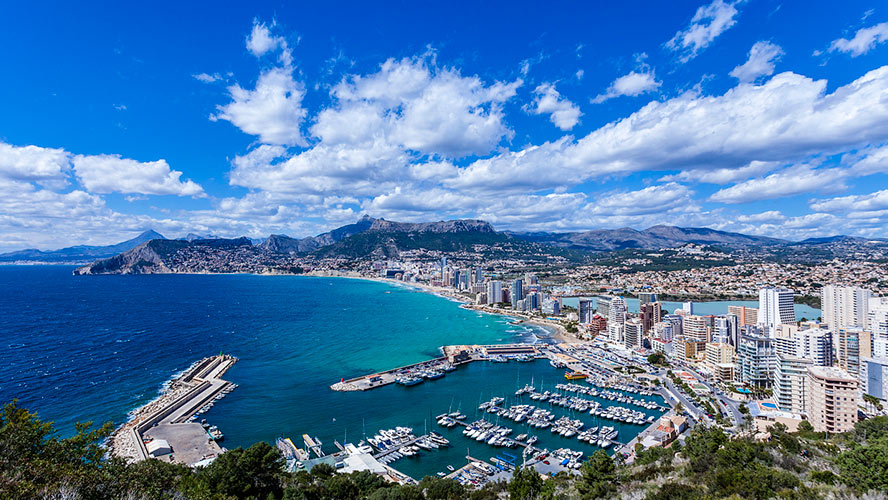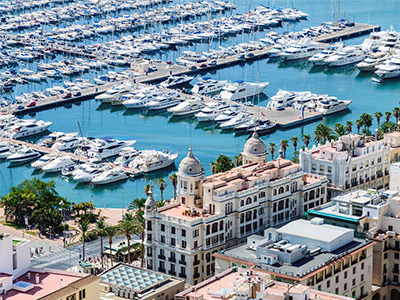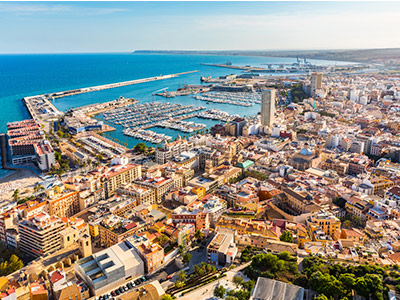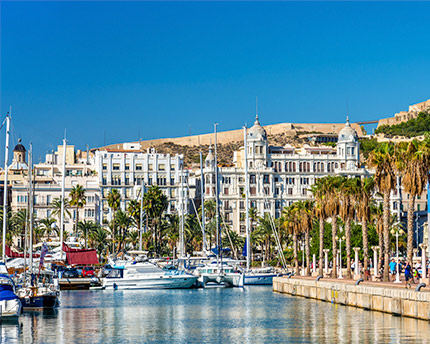The Port of Alicante, which runs parallel to the famous boulevard known as the Explanada de España (link interno), is, at the same time, a homage to the sea and the city’s multicultural history. Situated at the foot of the magnificent Santa Bárbara Castle (link interno), its official status as a maritime port dates back, no more and no less, to the year 1271, under the rule of Alfonso X of Castile. These days, the complex not only hosts fishing and commercial events but is also home to a marina where you can find a comprehensive range of leisure options. Bars and cafeterias, restaurants and nightclubs, a casino and countless shops make the area a genuine hub for tourists. If we add in the regular events and concerts that are held at the port, as well as the recent announcement that it will be the location for the prestigious yacht race Volvo Ocean Race, you’ll see that fun in this unique place on the Mediterranean is guaranteed. Read on for more information on the Port of Alicante.
Historical anecdotes about the Port of Alicante
The advanced facilities of the present-day Port of Alicante was once the site, in the fifth century BC, of a primitive wharf, established by people of Iberian origin, from where their produce would be offloaded. This is demonstrated by the excavations carried out at the so-called Tossal de les Basses, an archaeological site that can be visited situated less than six kilometres from the northern side of the current port. Thanks to the fact it is naturally protected from strong Mediterranean winds, the bay of Alicante has long been coveted by various succeeding civilisations: firstly the Romans, followed by the Moors and lastly the Christians.

It has also been the scene of such decisive events as the end of the Spanish Civil War ― and with it that of the Second Republic. Thousands of people made their way to the port trying to escape Franco’s firing squads by embarking on one of the ships bound for Latin America. The vast majority of them failed, however, as they were blocked by the vessels of an Italian fascist general.
Port of Alicante in the present day
These days, the Port of Alicante is teeming with life under the outstretched shadow of Santa Bárbara Castle, a majestic fortification of Moorish origin perched on the peak of Mount Benacantil at 166 metres above sea level. Naturally connected to the rest of the city, the best way to get to the port is via the Explanada de España, a lovely seaside promenade lined with scores of palm trees.
The most interesting and lively part of the port complex is that known as the Marina Deportiva del Puerto de Alicante, a set of docks built in 1999, which together add up to 748 berths. This part of the port is also where the most entertainment venues are located, with special mention going to the restaurants and nightclubs that light up and fill with people come nightfall. However, if you’re looking for something to do during the day that is suitable for all ages, don’t miss the replica of the Santísima Trinidad, a scale reproduction of one of the Spanish Armada boats that took part in the famous Battle of Trafalgar. Functioning as a restaurant and nightclub, during the day it offers guided tours with a drink included in the price.
Restaurants at the Port of Alicante

As previously mentioned, one of the great attractions of Alicante’s marina is its restaurants. The range of options is extensive, although seafood is a common theme. Situated right in the heart of the marina is the restaurant Dársena founded in 1961 and specialising in rice dishes, as well as offering fresh fish and seafood brought straight from the nearby fish market on a daily basis. Also located on the inner harbour of the marina is Casino Mediterráneo, an entertainment and gaming house that also boasts excellent dining options: the à la carte restaurant Azar and the buffet restaurant Las Ventanas del Casino.
If you head towards the Explanada de España, which is, after all, an inextricable part of the marina, you’ll find other highly-recommended restaurants. Such is the case of the famous Real Liceo Casino de Alicante, an age-old institution that has evolved into quite the gastronomic project. At the restaurant, housed in one of the city’s most emblematic nineteenth-century buildings, you’ll find a menu with gourmet cuisine at good prices. However, if you’re looking for something a little more informal, on El Postiguet beach (link interno) – Alicante’s main beach – is Puerta del Mar-Kiosko Rafael, a Mediterranean restaurant that functions as a cafeteria in the afternoon.
Nightclubs at the Port of Alicante
Alicante in general terms, and the port in particular, are one of the most famous party destinations on the Costa Blanca. The city’s nightlife, which is especially lively during the summer months, consists of a wide range of establishments, from pubs and beach bars to large nightclubs with outdoor terraces. Around the Explanada, for example, you can head to Club Concerto, a renowned place in Alicante’s nightlife scene, due to the versatility of its atmosphere – inspired by typical Miami bars and clubs – and the varied music played by famous DJs.
The port is also home to large nightclubs: Katamaran Discoteque, at the most southerly point, and Marmarela, right in the marina. The former is a great option for fans of electronic music boasting live-shows with musicians and dancers included. The latter, situated right on the Muelle Levante, is perhaps the most famous of all the port’s establishments. A super nightclub spanning 2,000 square metres, it boasts a terrace with sea views, a restaurant, a swimming pool and a Jacuzzi. Open everyday from midday until sunrise, its night-time programme usually includes sets from world-famous DJs and on Sundays you can catch deep house sessions with a barbecue included.
The Ocean Race: a museum dedicated to sailing regattas

In the year 2010 Alicante hosted for the first time the Volvo Ocean Race (now only known as the Ocean Race), the hardest yacht race in the world. As a result, in 2013 a museum dedicated to the event was designed and opened, which can today be visited at the Marina Deportiva del Puerto de Alicante. Split across two floors, the museum is home to an interactive space where you can learn not only about the history of yachting but also its more technical side. What’s more, at The Ocean Race Museum you will also get the opportunity to see both the exterior and interior of a real competition boat, the Brasil 1. You’ll also be able to experience the sensation of sailing using The Ride, a simulator that is highly immersive thanks to its in-built technology.





































































